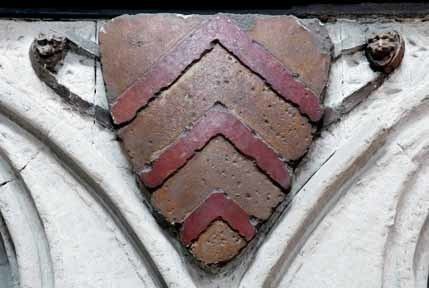Noble family De Clare | Name Richard Clare, | |
 | ||
Died July 14, 1262, Waltham, United Kingdom Spouse Maud de Lacy, Countess of Hertford and Gloucester (m. 1238–1262) Children Gilbert de Clare, 7th Earl of Gloucester, Thomas de Clare, Lord of Thomond, Rohese de Clare Parents Gilbert de Clare, 5th Earl of Gloucester, Isabel Marshal Grandchildren Margaret de Clare, Elizabeth de Clare Similar People Isabel de Clare - 4th Countess, Isabel Marshal, Margaret de Clare - Baroness, Eleanor de Clare, Joan of Acre | ||
Richard de Clare, 5th Earl of Hertford, 6th Earl of Gloucester, 2nd Lord of Glamorgan, 8th Lord of Clare (4 August 1222 – 14 July 1262) was son of Gilbert de Clare, 4th Earl of Hertford and Isabel Marshal. On his father's death, when he became Earl of Gloucester (October 1230), he was entrusted first to the guardianship of Hubert de Burgh. On Hubert's fall, his guardianship was given to Peter des Roches (c. October 1232); and in 1235 to Gilbert, Earl Marshall. He was also a powerful Marcher Lord in Wales and inherited the Lordship of Glamorgan upon the death of his father.
Contents

Marriage
Richard's first marriage to Margaret or Megotta, as she was also called, ended with either an annulment or her death in November 1237. They were both about 14 or 15. The marriage of Hubert de Burgh's daughter Margaret to Richard de Clare, the young Earl of Gloucester, brought de Burgh into some trouble in 1236, for the earl was as yet a minor and in the wardship of King Henry III, and the marriage had been celebrated without the royal licence. Hubert, however, protested that the match was not of his making, and promised to pay the king some money, so the matter passed by for the time. Even before Margaret died, the Earl of Lincoln offered 5,000 marks to King Henry to secure Richard for his own daughter. This offer was accepted, and Richard's second marriage, on 2 February 1238, was to Maud de Lacy, daughter of John de Lacy, 1st Earl of Lincoln
Military career
He joined in the Barons' letter to the Pope in 1246 against the exactions of the Curia in England. He was among those in opposition to the King's half-brothers, who in 1247 visited England, where they were very unpopular, but afterwards he was reconciled to them.
In August 1252/3 the King crossed over to Gascony with his army, and to his great indignation the Earl refused to accompany him and went to Ireland instead. In August 1255 the king sent him and John Maunsel to Edinburgh to find out the truth about reports which had reached the King that his son-in-law, Alexander III, King of Scotland, was being coerced by Robert de Roos and John Balliol. They were to try to bring the young King and Queen to him. The Earl and his companion, pretending to be the two of Roos's knights, obtained entry to Edinburgh Castle, and gradually introduced their attendants, so that they had a force sufficient for their defence. They gained access to the Scottish Queen, who complained to them that she and her husband had been kept apart. They threatened Roos with dire punishments, so that he promised to go to the King.
Meanwhile, the Scottish magnates, indignant that their castle of Edinburgh was in English hands, proposed to besiege it, but they desisted when they found they would be besieging their King and Queen. The King of Scotland apparently travelled south with the Earl, for on 24 September they were with King Henry III at Newminster, Northumberland. In July 1258 he fell ill, supposedly poisoned together with his brother William by his steward, Walter de Scotenay. He recovered, but his brother died.
Death and legacy
Richard died at John de Griol's Manor of Asbenfield in Waltham, near Canterbury, on 14 July 1262 at the age of 39; it was rumoured that he had been poisoned at the table of Piers of Savoy. On the following Monday he was carried to Canterbury where a requiem mass was sung; his body was then taken to the canons' church at Tonbridge and interred in the choir. From there it was taken to Tewkesbury Abbey and buried 28 July 1262, with great solemnity in the presence of two bishops and eight abbots in the presbytery at his father's right hand. Richard's own arms were: Or, three chevronels gules.
Richard left extensive property, distributed across numerous counties. Details of these holdings were reported at a series of inquisitions post mortem that took place after his death.
Family
Richard had no children by his first wife, Margaret (or "Megotta") de Burgh. By his second wife, Maud de Lacy, daughter of the Surety John de Lacy and Margaret de Quincy, he had:
His widow Maud, who had the Manor of Clare and the Manor and Castle of Usk and other lands for her dower, erected a splendid tomb for her late husband at Tewkesbury. She arranged for the marriages of her children. She died before 10 March 1288/9.
